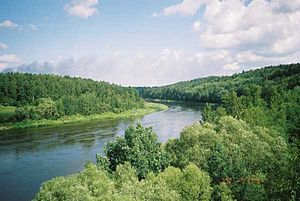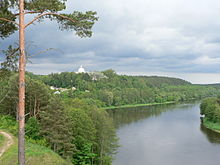Neman
| Neman Nyoman Nemunas Niemen | |
|---|---|
 The Neman near Alytus | |
 Map highlighting Neman | |
| Etymology | possible Slavic word for monster |
| Location | |
| Country | Belarus, Lithuania, Russia |
| Cities | Stowbtsy, Grodno, Druskininkai, Alytus, Birštonas, Prienai, Kaunas, Jurbarkas, Sovetsk |
| Physical characteristics | |
| Source | |
| • location | Southwest of Minsk, Belarus |
| • coordinates | 53°15′10″N 27°18′21″E / 53.25278°N 27.30583°E |
| • elevation | 176 m (577 ft) |
| Mouth | Curonian Lagoon |
• location | West of Šilutė, Lithuania |
• coordinates | 55°20′12″N 21°14′50″E / 55.33667°N 21.24722°E |
• elevation | 0 m (0 ft) |
| Length | 937 km (582 mi) |
| Basin size | 98,200 km2 (37,900 sq mi) |
| Discharge | |
| • location | Curonian Lagoon, linked to the Baltic Sea |
| • average | 678 m3/s (23,900 cu ft/s)[1] |
The Neman, Niemen, Nyoman, Nemunas or Memel
The largest river in Lithuania, and the third-largest in Belarus, it is navigable for most of its length. It starts from two small headwaters merging about 15 kilometers (9 mi) southwest of the town of Uzda – about 55 km (34 mi) southwest of capital city Minsk. Only 17 kilometres (11 mi), an eastward meander, contributes to the Belarus–Lithuania border. Thereafter the river includes notable loops along a minor tectonic fault.
Its
Numbers
- The total length of the Nioman/Nemunas/Neman is 937 km (582 mi).Kaliningrad oblast.
- Its greatest depth is 5 m (16 ft), and at its widest it extends about 500 m (1,600 ft).
- The Nioman/Nemunas/Neman is a slow river; it flows at about 1 to 2 m/s (3.3 to 6.6 ft/s).
- During floods, water discharge can increase up to 11-fold, to more than 6,800 m3/s (240,000 cu ft/s). Severe floods occur on the lower reaches of the river about every 12 – 15 years, which sometimes wash out bridges.[3]

- The Nioman/Nemunas/Neman is an old river, dating back to the last glacial period. Its valley is now up to 60 meters (200 ft) deep and 5 km (3 mi) broad.
- It has about 105 first-class tributariesare longer than 100 km (62 mi).
- In the complete Nioman/Nemunas/Neman basin, there are tributaries extending to the 11th order.
- The Nemunas basin in Lithuania drains more than 20,000 rivers and rivuletsand covers 72% of Lithuania's territory.
- The total area of the Nioman/Nemunas/Neman basin is 98,200 km2 (37,900 sq mi),[2] 34,610 km2 (13,360 sq mi) of which are within Belarus,[2] the Lithuanian portion of this basin is 46,695 km2 (268 sq mi).
- Valley of Neman in Grodno Region is the lowest point above sea level in Belarus at 80 to 90 m (260 to 300 ft).[4]
River course
Nemunas loops


Due to their location, "The Nemunas loops" are often described using the Lithuanian name for the river. In 1992
Delta
At its
Tributaries
The following rivers are tributaries to the river Neman/Nemunas (from source to mouth):
- Left:
- Right: Western Berezina, Gauja, Kotra, Haradnichanka, Merkys, Verknė, Strėva, Neris, Nevėžis, Dubysa, Mituva, Jūra, Minija
Largest settlements on the river
From west to east, the largest settlements are
.Significance in culture
Ptolemy referred to Neman as Chronos (although competing theories suppose Chronos was in fact Pregolya).
The river has lent its name to the Neman Culture, a Neolithic archaeological subculture.[6]

In
The border between the

| German lyrics | Approximate English translation |
|---|---|
| Von der Maas bis an die Memel, Von der Etsch bis an den Belt |
From the Meuse to the Memel, From the Adige to the Belt |
Lithuanians refer to the Nemunas as "the father of rivers" (Nemunas is a masculine noun in Lithuania). Countless companies and organizations in Lithuania have "Nemunas" in their name, including a folklore ensemble, a weekly magazine about art and culture, a sanatorium, and numerous guest houses and hotels. Lithuanian and Polish literature often mention the Nemunas. One of the most famous poems by Maironis starts:
| Lithuanian lyrics | Approximate English translation |
|---|---|
| Kur bėga Šešupė, kur Nemunas teka | Where the Šešupė runs, where the Nemunas flows |
| Tai mūsų tėvynė, graži Lietuva | That's our fatherland, beautiful Lithuania |
Almost every Lithuanian can recite these words by heart.
Smaller rivers and rivulets in Lithuania with names
The etymology is disputed: some say that "Nemunas" is an old word meaning "a damp place",[9] while others that it is "mute, soundless river" (from nemti, nėmti "to become silent", also memelis, mimelis, mėmė "slow, worthless person").[10] The name is possibly derived from the Finnic word niemi "cape".[11]
Art critics praised its depiction in the paintings by Michał Kulesza.[12][13]
Economic significance

Much of the river is used for fishing, hydropower generation, water supply, industry, agriculture, recreation, tourism, and water transport.
Lithuania has tabled local plans to dredge it, below Kaunas, to make it more consistently usable.[14]
The largest cities on the river are Grodno in Belarus, Alytus and Kaunas in Lithuania, and Sovetsk in the Kaliningrad Oblast of Russia. The river basin has a population of 5.4 million inhabitants. Industrial activities in the Belarusian section include metal processing, chemical industries, pulp and paper production, and manufacturing of building materials, as well as food-processing plants. In Lithuania, the city of Kaunas, with about 400,000 inhabitants, is the country's principal user of the river; the local industries that impact the river are hydropower generation, machinery, chemical, wood processing and paper production, furniture production, textile and food-processing. In Kaliningrad, industrial centers near the river include Sovetsk and Neman, which have large pulp and paper production facilities.
Above Kaunas a dam was built in 1959 to serve the Kaunas Hydroelectric Power Plant. The resulting Kaunas Reservoir (Lithuanian: Kauno marios) is the largest such lake in Lithuania. It occupies 63.5 km2 (24+1⁄2 sq mi); its length is 93 km (58 mi); its greatest depth is 22 m (72 ft). The reservoir is a popular destination for Lithuanian yachting.
The
Biological communities
Fish found include the:
Its tributaries have borne stone
Environmental issues

A report by the
Co-operation which would be beneficial is complicated by the geographical split between three nations but water quality improvement initiatives are underway.
See also
- List of rivers of Europe
- Normandie-Niemen(a fighter squadron, later regiment (of three squadrons) of the French Air Force)
- Memelland
- East Prussia
Notes
References
- ^ https://www.worldatlas.com/seas/baltic-sea.html
- ^ a b c d "Main Geographic Characteristics of the Republic of Belarus. Main characteristics of the largest rivers of Belarus". Land of Ancestors. Data of the Ministry of Natural Resources and Environmental Protection of the Republic of Belarus. 2011. Archived from the original on 15 January 2014. Retrieved 27 September 2013.
- ^ Floods and fires in Lithuania
- ^ "Main Geographic Characteristics of the Republic of Belarus". Land of Ancestors. The Scientific and Production State Republican Unitary Enterprise "National Cadastre Agency" of the State Property Committee of the Republic of Belarus. 2011. Archived from the original on 21 September 2013. Retrieved 20 September 2013.
- ^ "The Great Nemunas Loops". Nemunas Loops Regional Park. Archived from the original on February 26, 2008. Retrieved 2009-01-10.
- S2CID 162896841.
- ^ McLynn, Frank (1998). Napoleon: A Biography. Pimlico.[page needed]
- ^ Leo Tolstoy (1915). War and Peace. J.M. Dent. p. 200.
niemen river war and peace.
- ^ Aleksandras Vanagas. Lietuvių hidronimų etimologinis žodynas. 227 psl., – Vilnius: Mokslas, 1981.
- ^ Petronytė, Jurga (2016-08-02). "Mėmelis ar Klaipėda?". Vakarų ekspresas. Archived from the original on 2016-08-04.
- ^ Tadeusz Lehr-Spławiński. O pochodzeniu i praojczyźnie Słowian. – Poznań, 1946.
- ^ Kraszewski, Józef Ignacy (1847). "Pejzaż, Michał Kulesza". Tygodnik Petersburski. 18.
- ^ Gr..., M...; [Michał Grabowski, pseud. of Edward Tarsza] (1849). "5". Projekta Artystyczne w Litwie. Warsaw: S. Orgelbrand.
{{cite book}}:|work=ignored (help) - ^ "Transportation initiatives in the Baltic states". Archived from the original on 2006-09-25. Retrieved 2006-12-02.
- ^ Report on the Neman basin issued by the Swedish EPA Archived February 18, 2006, at the Wayback Machine
External links
- (in Polish) Niemen (the Neman) in the Geographical Dictionary of the Kingdom of Poland (1886)
- (in English) Glaciation in Lithuania
- (in English) Biotopes in the Neman and its tributaries
- (in English) Atlantic salmon in the Neman River
- Agata Lewandowski, Łosośna - the Unknown Valley. Not the Last Arrival for...Puciłki, "Znad Wilii", nr 3(79) z 2019 r., p. 58–64, (in Polish)http://www.znadwiliiwilno.lt/wp-content/uploads/2019/10/Znad-Wilii-3-79m-1.pdf
- Helena i Leonard Drożdżewiczowie, Antologia Doliny Łosośny, (in Polish)http://193.0.118.54/search/query?term_1=Antologia+Doliny+%C5%81oso%C5%9Bny&theme=nukat


